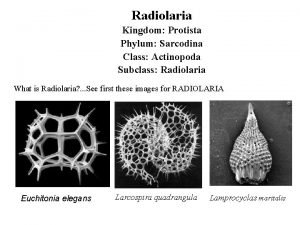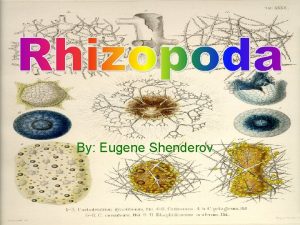Radiolarians have silica exoskeletons Radiolarians secrete glassy exoskeletons





- Slides: 5

Radiolarians have silica exoskeletons Radiolarians secrete glassy exoskeletons made of silica. These skeletons give the unicellular organisms a distinct shape, exhibiting either bilateral or radial symmetry. The shells of different species form many elaborate and beautiful shapes, with pseudopods extruding outward along spiky projections of the skeleton. Microtubules support these cytoplasmic projections. Rhizaria Actinosphaerium with needlelike pseudopods.

Radiolaria have been studied extensively by paleontologists because of their well-established presence in the fossil record. However, it is only recently that other biogists have become interested in these unicellular protists, and for the same reason that paleontologists were able to find and examine fossils of the organisms in the first place -- their unique skeleton. Crystallized from opaline silica, this unusual and often strikingly beautiful characteristic of these organisms is their primary morphological characteristic, providing both a basis for their classification and an insight into their ecology. Silica is an important material, found extensively in the Earth's crust as a raw material. It is also vitally important to the protection and survival of radolarians, as well as for preserving the record of their existence in the world's oceans throughout prehistoric and modern times. Silica (Si. O 2), being a highly ceramic compound with a complex crystal structure, affords a very durable skeleton. It is because of this sturdy crystal structure of silica that the fossil record for Radiolaria is well preserved. Varying slightly from one subclass to another, the skeletons of radiolarians are generally organized around spicules, or spines, which are sharp, dense outcroppings from the main skeletal mass. Formed from the fusion of many of these spines is the outermost skeleton, the cortical shell. Connecting this shell to the many concentrically organized inner shells are bars or beams, which also serve to strengthen and support the entire assembly. Within and extending into the many chambers created by this complex structure is the single cell of the organism.

When viewed on a larger scale, Radiolaria are incredibly diverse in the form their skeletons may take, ranging from spherical to rod-shaped, and radial to bilaterally symmetrical. To this day, the process by which a single cell is able to produce such amazing complexity remains under dispute, and continues to be one of the most active areas of research involving Radiolaria. Proposed methods of production include direct chemical metamorphosis of the cytoplasm, or perhaps scretion of a fluid form of silica from the cell that later polymerizes to form the skeleton. Additional research is being focused toward determining the benefits and selective advantage of producing a skeleton at all. Although originally thought to be quite simple internally, Radiolaria are actually some of the most complex extant protists. Indicative of the high degree of specialization they exhibit, their cytoplasmic mass, which constitutes the majority of the space within the cell, is divided into two regions separated by a perforated membrane. The first of these regions is the central mass, also known as the central capsule, and the second is the extracapsulum, a peripheral layer of cytoplasm surrounding the central capsule. The central capsule contains the organelles common to all eukaryotic cells, such as the mitochondria and vacuoles, while the extracapsulum is characterized by its thread-like extensions of cytoplasm, the rhizopodia. Aiding in the capture of prey, the rhizopodia are crucial in obtaining the energy necessary for the successful completion of the Radiolarian life cycle. Additionally, the rhizopodia act to increase the surface area of the cell, improving the rates of release of metabolic wastes and the uptake of oxygen. The separation of the cytoplasm is thought to allow for increased control of the diffusion of large molecules within the cell, such as fat globules, and organelles.

The life cycle of the Radiolaria is distinguished by its nonmotile existence, and many of its morphological adaptations reflect the selection pressure toward increased buoyancy. These include the presence of lipids, or fat droplets, in the central capsule and extending into the rhizopodia, along with bubble-like compartments filled with gases, called alveoli, localized to the extracapsulum. Together, these adaptations serve to decrease the density of the organism, and thus increase its buoyancy. Hence, the cytoplasmic separation previously described may be intimately tied to controlling the buoyancy of the organism.

Living Actinopods : Though the skeleton is the easiest portion of a radiolarian to study, it is largely inorganic. The living mass of the cell lies in and around the skeleton, and features many fine thread-like rhizopodia that serve to capture food and to increase the surface area of the organism (see image above at left). At right, a Heliozoan, or "sun animal". This is not an animal at all, but another group of protists believed to be closely related to the Radiolaria. You can see the obvious similarity of rhizopodia.









